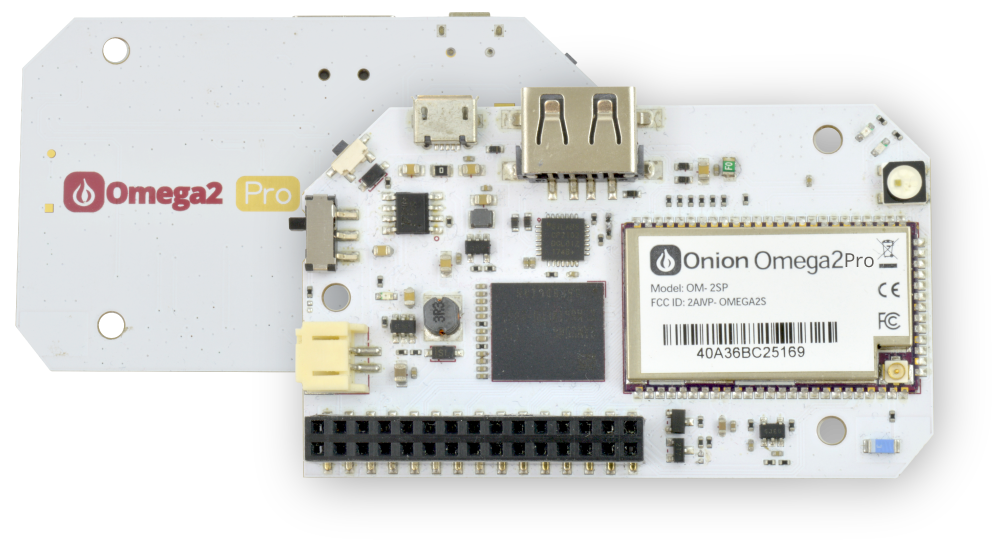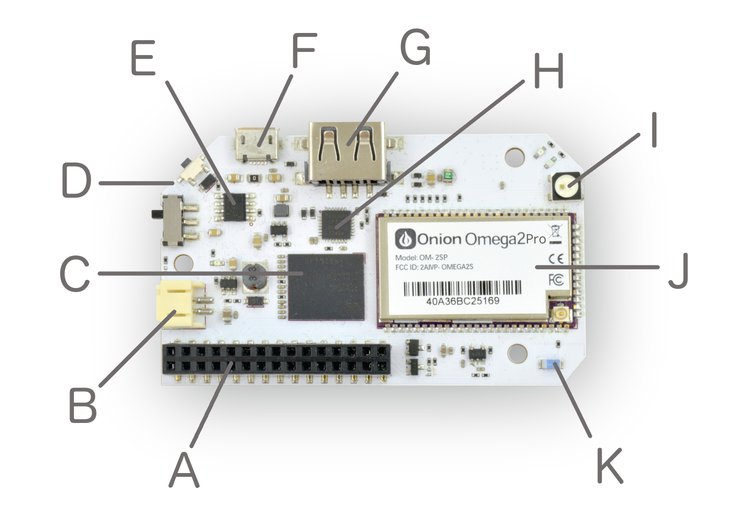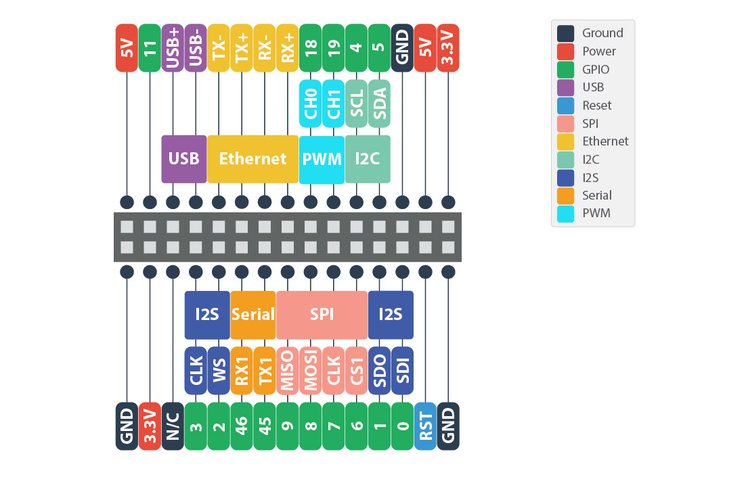Single Board Computer with WiFi and gigabytes of storage
The Omega2 Pro single board computer is meant for prototyping and developing IoT applications and products that require large amounts of reliable storage in a small form-factor. It runs Linux out of the box and has built-in WiFi connectivity, all in a package that’s smaller than a credit card.
- Wi-Fi enabled Linux-based single board computer for IoT applications
- Hardware design and OS are open source
- Dual mode 2.4 GHz 802.11 b/g/n Wi-Fi - simultaneously host a WiFi access point and connect to existing WiFi networks
- CPU, memory, and flash storage are built-in
- Runs OpenWRT Linux operating system out of the box
- Features USB, ethernet, MicroSD, 2x UARTs, I2C, SPI, GPIOs interfaces
- Can be powered by LiPo batteries, and charge batteries when connected to power
- Easy command line access through MicroUSB Port

The Omega2 Pro is a standalone single board computer that is WiFi-enabled, runs Linux, and has gigabytes of available storage. It fits everything needed for development – a processor, memory, WiFi radio and antenna, gigabytes of storage, many I/Os and ports – into a tiny 73 x 44 mm board.
Based on the Omega2S+ module and featuring an on-board 8GB eMMC chip, the Omega2 Pro has the largest amount of built-in storage in the entire Omega2 product family. This makes it a great development board for IoT products that require large amounts of reliable storage. When graduating from development to production, it can also serve as a reference design for using the Omega2S modules with eMMC storage.
Hardware

A. 30-pin expansion header
G. USB host
B. Battery connector
H. USB-to-serial
C. 8 GB eMMC
I. Full-color LED
D. Programmable button
J. Omega2 core
E. Power management
K. Chip antenna
F. Micro USB (power & serial)
The Omega2 Pro has all of the hardware that’s needed for a solid development board:
– Extensive I/O
– Physical USB and MicroUSB ports for easy connectivity
– A USB-to-Serial for command-line access over MicroUSB
– LiPo battery support and JST-PH battery connector
– Dev friendly power switch, reset button, status LEDs, and full-color LED
– Small but mighty, measuring only 73 x 44 mm – smaller than a credit card
The Omega2 Pro features extensive I/O – USB, Ethernet, I2C, UART, I2S, SPI, PWM, and GPIOs – making it easy to interface with other devices and components. There is a USB host port to easily connect various USB devices. The I/O header on the Omega2 Pro is compatible with the existing ecosystem of plug-and-play Omega2 Expansions, allowing users to easily add functionality to their device.
An on-board battery management chip makes the Omega2 Pro compatible with LiPo batteries: they can be used as the main power source, and will be charged when the Omega is connected to USB power. Use a battery to make your application portable, or to act as a back-up power supply.
During early development, easy access to the command line is essential for quick iterations. The built-in USB-to-serial chip provides reliable, always-on access to the Omega’s command line through the MicroUSB port.
Developers can use the full-color WS2812B LED to indicate status of their programs. The LED is driven by a hardware pulse width modulation (PWM) controller, so the colors and transitions are always smooth.
Software
The Omega2 Pro runs an Onion-customized version of OpenWRT Linux, based on the modern 4.14 Linux kernel. Users can rely on the Linux system to abstract away complexity in device operation and on the networking and cryptography stack to simplify connectivity. The OS is open-source and available on GitHub, allowing users to customize it to meet their individual needs.
In the default configuration, the OS runs on the eMMC storage and makes use of a 384 MB swap file, giving the Omega2 Pro 512 MB of effective RAM. The added storage and memory allows users and developers to build rich, modern applications, with plenty of space to hold libraries, assets, media, and more.
The Omega2 Pro supports Node-RED, a flow-based, visual programming tool that runs in the browser, again thanks to the added storage and memory, The Node-RED editor makes it easy to wire together flows using the wide range of nodes in the palette. Flows can be then deployed to the runtime in a single-click.
Developers can also use their programming language of choice to build their applications. Supported programming languages include:
– Python3
– NodeJS 8.10
– GoLang
– Rust
– Ruby
– C and C++
– Shell
– PHP
– Perl
Features & Specifications
| Processor | 580 MHz MIPS CPU |
| Memory | 512 MB (128 MB RAM and 384 MB flash swap file) |
| Storage | 8 GB |
| Connectivity | 2.4 GHz b/g/n Wi-Fi |
| Operating System | OpenWrt 18.06 Linux |
| Battery Support | LiPo battery management & JST-PH battery connector |
| Antenna | 2 dBi directional chip antenna & U.FL connector for external antenna |
| Dimensions | 73 mm x 44 mm |

Frequently asked questions
Find a list of Onion distributors HERE
Fill out the form here and our sales team will get back to you with volume pricing info and more.
See our volume ordering page for all of the details.
